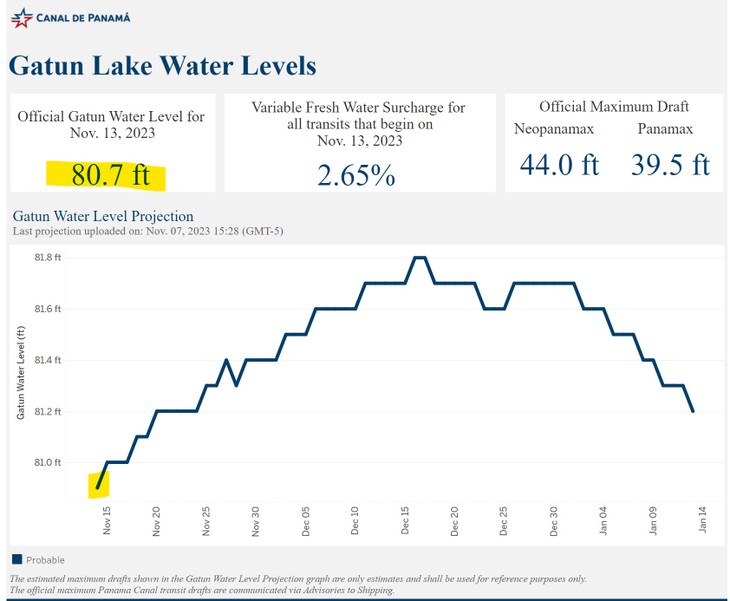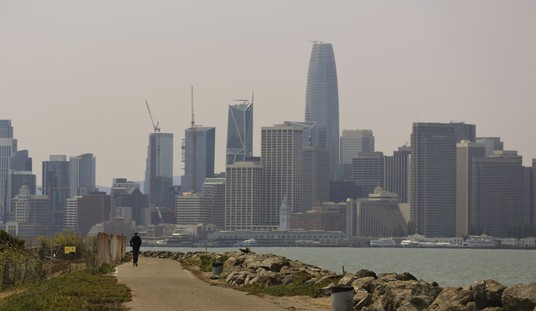There are a few more things roiling the waters as far a the oceanic shipping industry is concerned that I thought were kind of interesting.
I’ve already covered the continuing Panama Canal issue, but that low water and reduced traffic is causing it’s own corollary inflationary issues. While the traffic snafu continues unabated…
99 on Thursday, 112 on Friday and 123 ships today – the queue at both ends of the Panama Canal is growing https://t.co/7068I8zsou pic.twitter.com/lGejjhmawc
— Sam Chambers (@SamChambers) November 13, 2023
…and the reduction in the number of ships being allowed to make the transit heads towards 18 by the end of February, some operators are taking extraordinary measures to ensure their cargo gets across the isthmus.
They are ponying up the cash, and not just the extra required to make the day’s cut – they’re buying a license to jump the line entirely. Liquid natural gas carriers are in a time crunch, and I had never before known they needed to be.
It turns out, if they sit around too long, their cargo boils off.
Fun fact: each LNG ship has a boil-off rate and calorific value, distance from port and can be sold at any time, so they're modelled like Options derivates.
I worked on an HPC grid that crunched the numbers on gas fleets for an energy company a few years ago.
— Luke Puplett (@lukepuplett) November 13, 2023
It’s really interesting. Before LNG became the fuel of choice, vessels would actually use the naturally occurring “boil off” – which has to, to relieve pressure – to partially fuel the ship itself.
Liquefied natural gas (LNG) tankers are burning more dirty fuel oil than normal after the price of their super-chilled cargo soared above that of oil, trade and shipping sources said.
LNG tankers often use some of their cargo, stored in liquid form at minus 163 degrees Celsius, for power, as a small portion tends to evaporate or “boil off” during transit and needs to be removed from the tanks anyway to avoid a build up of pressure.
Older LNG tankers run on steam turbines that burn a combination of fuel oil and boil-off gas, while vessels built after 2014 have more efficient dual or tri-fuel diesel engines that burn a mixture of marine gasoil and boil-off gas.
When gas prices were lower, operators chose to boil off more of their cargoes over using fuel oil to power the ships.
But the price of LNG is so high that they are trying to avoid using more than necessary of the stored gas and are instead relying on cheaper fuel oil, the sources told Reuters.
The boil-off rate with a vessel sitting in the warm tropical sun waiting to cross through the Canal is, I guess, significant enough that it’s worth paying literally millions to get that boat floating along.
At the prices LNG is going for and with demand as high as it is, the operators can afford to pay the additional passage fee, but that is a crippling amount of money for your average shipper.
…“You are getting close to $4.5 million to use the canal, so that is pricing out a lot of ships,” Oystein Kalleklev, chief executive officer of Flex LNG Ltd. and Avance Gas Holding Ltd., said during a conference call Wednesday when asked about the state of the canal.
What does that do to the LNG price on the backside? I’m not sure how those markets are traded and where the shipping is added to the cost. Things have been so unstable, I know now in a lot of industries there aren’t locked in contracts with shipping included. Now you either pay it yourself, or eat the freight the wholesaler hits you for when he ships. However they dock you for it, the costs are hitting the consumer’s bottom line in the end.
According to report by Vanguard, NLNG Limited addresses the cooking gas price surge
3 major issues were the exchange rate, crude oil prices, and Panama Canal-related transport costs
Meanwhile, the price of 1kg cooking gas has gone up by 61% to N1,200 from N696 sold in June 2023 pic.twitter.com/Hx94EbwFXY
— Oaksintelligence (@Oaksintel) November 13, 2023
Finally, thanks to the appearance of a tropical storm that formed over Panama, Gatun Lake is projected to fill a bit – providing a little breathing room – but the long term outlook is still dreary. Again, because of that forecasted robust El Niño that is also set to bedevil refilling our Mississippi River.

On top of all that bad news for the consumer came even more because of meddling European Union Green weenies. As if getting your ship from point A to point B wasn’t expensive enough with droughts and wars, EU carbon emissions penalties and fees saving the boiling earth are going to really make your wallet bleed.
The cost of fuel in shipping’s energy transition will rise alongside the costs of compliance and the price implications of EU carbon emissions could be equivalent to 50% of fuel costs, an official at Yara Marine Technologies said.
The EU Emissions Trading System is scheduled to be extended to cover maritime transportation from 2024 and introduce the FuelEU Maritime regulations on the greenhouse gas intensity of bunker fuels from 2025.
Operating costs, particularly those related to fuel, will increase, as will the cost of compliance with regulatory limits on greenhouse gas emissions, Aleksander Askeland, CSO of Yara Marine Technologies, a subsidiary of Yara International, told S&P Global Commodity Insights.
Yara anticipated that in some cases the cost of EUA credits could even be equivalent to 50% of the fuel cost, Askeland said.
It is SUCH a scam.
See how this works?
They’ll have bugs on your plate because no one can afford to get anything else to you.








Join the conversation as a VIP Member